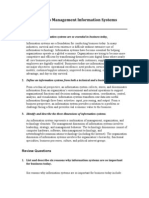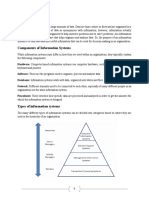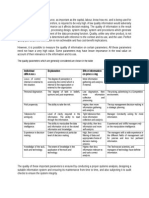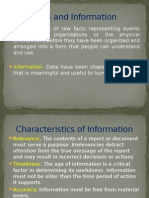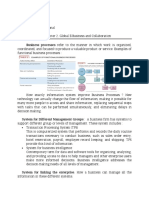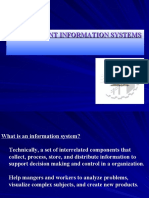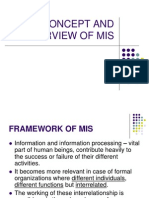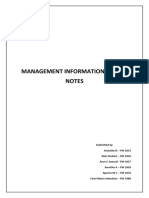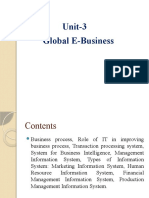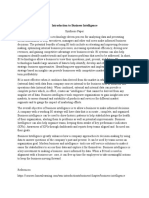MIS Tasmi
MIS Tasmi
Uploaded by
Tasmiya MunmunCopyright:
Available Formats
MIS Tasmi
MIS Tasmi
Uploaded by
Tasmiya MunmunOriginal Title
Copyright
Available Formats
Share this document
Did you find this document useful?
Is this content inappropriate?
Copyright:
Available Formats
MIS Tasmi
MIS Tasmi
Uploaded by
Tasmiya MunmunCopyright:
Available Formats
An organized approach to the study of the information needs of an organizations management at every level in making operational, tactical, and
strategic decisions. Its objective is to design and implement procedures, processes, and routines that provide suitably detailed reports in an accurate, consistent, and timely manner. In a management information system, modern, computerized systems continuously gather relevant data, both from inside and outside an organization. This data is then processed, integrated, and stored in a centralized database (or data warehouse) where it is constantly updated and made available to all who have the authority to access it, in a form that suits their purpose. Digital Firm: The digital firms can be defined along several dimensions. A digital firm is one in which nearly all of the organizations significant business relationships with customers, suppliers, and employees are digitally enabled and mediated. Core business processe: Core business processes are accomplished through digital networks spanning the entire organization or linking multiple organizations. Business processes refer to the set of logically related tasks and behaviors that organizations develop over time to produce specific business results and the unique manner in which these activities are organized and coordinated. Developing a new product, generating and fulfilling an order, creating a marketing plan, and hiring an employee are examples of business processes, and the ways organizations accomplish their business processes can be a source of competitive strength. Key corporate assets Key corporate assets is intellectual property, core competencies, and financial and human assetsare managed through digital means. In a digital firm, any piece of information required to support key business decisions is available at any time and anywhere in the firm .Digital firms sense and respond to their environments far more rapidly than traditional
firms, giving them more flexibility to survive in turbulent times. Digital firms offer extraordinary opportunities for more global organization and management. By digitally enabling and streamlining their work, digital firms have the potential to achieve unprecedented levels of profitability and competitiveness. Time Shifting refers to business being conducted continuously,24/7,rather than in narrow workday time bands of 9 A.M to 5 PM . Space shifting means that work takes place in a global workshop, as well as within national boundaries. Information can flow seamlessly among different parts of the company and between the company and external entitiesits customers, suppliers, and business partners. More and more organizations are moving toward this digital firm vision.
PERSPECTIVES ON INFORMATION SYSTEMS Information systems can be best be understood by looking at them from both atechnology and a business perspective. What Is an Information System? An information system can be defined technically as a set of interrelated components that collect (or retrieve), process, store, and distribute information to support decision-making and control in an organization. In addition to supporting decision making, coordination, and control, information systems may also help managers and workers analyze problems, visualize complex subjects, and create new products. Information systems contain information about significant people, places, and things within the organization or in the environment surrounding it. By information we mean data that have been shaped into a form that is meaningful and useful to human beings. Data, in contrast, are streams of raw facts representing events occurring in organizations or the physical environment before they have been organized and arranged into a form that people can understand and use.
Three activities in an information system produce the information that organizations need to make decisions, control operations, analyze problems, and create new productsor services. These activities are input, processing, and output. Input captures or collects raw data from within the organization or from its external environment. Processing converts this raw input into a more meaningful form. Output transfers the processed information to the people who will use it or to the activities for which it will be used. Information systems also require feedback, which is output that is returned to appropriate members of the organization to help them evaluate or correctthe input stage.
FIGURE 1-6 Functions of an information system An information system contains information about an organization and its surrounding environment. Three basic activitiesinput, processing, and outputproduce the information organizations need. Feedback is output returned to appropriate people or activities in the organization to evaluate
and refine the input. Environmental factors such as customers, suppliers, competitors, stockholders, and regulatory agencies interact with the organization and its information systems.
How Strategic Objectives Of Business Information Systems
Business processes are tasks and behaviors that organizations develop to produce specific business results. Corporate assets are developed through digital means. Electronically integrate business processes has become much more agile and adaptable and changing demands of suppliers and distributors. Strategic objectives of business information systems, what a company wants to get depends on what you are able to make their systems, increase sales with new high quality products at lowprices. There are six strategic objectives: Operational excellence: Improve operational efficiency for high profitability. The power of systems with very smart business practices and administration get an excellent operational efficiency. New products, services and business models: Systems and information technologies can create new products, services, and new business models. A business model is the way it is produced, distributed and sold to create wealth.
Good relationships with customers and suppliers: If it is a good example of how customers like to go back and buy more, increasing revenue and profits. The same applies to suppliers. The use of information technology systems and achieve good customer relations and supplier. Improved decision-making: Systems and information technology managers have made use of market data in real time when making decisions. Competitive Advantage It is when it gets one or more of these business objectives. Do better than their competitors do. Survival: Systems and information technology are necessary for business. There are ordinances, state, and federal regulations that require companies and their employees, keep records, including digital records.
You might also like
- Questions Chapter 1 & 2Document11 pagesQuestions Chapter 1 & 2dhwani1621100% (20)
- How Are Information Systems Transforming Business and What Is Their Relationship To Globalization?Document4 pagesHow Are Information Systems Transforming Business and What Is Their Relationship To Globalization?abdalla jaradat100% (1)
- Business @ The Speed Of Thought - Bill Gates (Using a Digital Nervous System)From EverandBusiness @ The Speed Of Thought - Bill Gates (Using a Digital Nervous System)No ratings yet
- Course Syllabus - English 102Document9 pagesCourse Syllabus - English 102api-311872487No ratings yet
- MIS Chapter 1 - Information SystemsDocument4 pagesMIS Chapter 1 - Information Systemsstephenwainaina994No ratings yet
- MIS-Unit 1Document61 pagesMIS-Unit 1BhagwatiNo ratings yet
- MIS Chapter 1Document22 pagesMIS Chapter 1Ropuk Paul 213-024No ratings yet
- Managing The Digital Firm: This Chapter Will Help You UnderstandDocument33 pagesManaging The Digital Firm: This Chapter Will Help You UnderstandSuman BhandariNo ratings yet
- ICT - PDF Version 1Document40 pagesICT - PDF Version 1Shah newaz ShawonNo ratings yet
- Mis NotesDocument64 pagesMis Notessucheta pandaNo ratings yet
- Why Are Organisations Trying To Integrate Their Business Process MIS ASSDocument14 pagesWhy Are Organisations Trying To Integrate Their Business Process MIS ASSAyanleke Julius Oluwaseunfunmi0% (1)
- Commerce 2ka3: Final ExamDocument53 pagesCommerce 2ka3: Final ExamKristelleNo ratings yet
- Introduction To Management Information SystemsDocument13 pagesIntroduction To Management Information SystemsYus MartianNo ratings yet
- Furthering Education: Creates Access To EducationDocument6 pagesFurthering Education: Creates Access To EducationBryan CapulongNo ratings yet
- 2 Ka 3Document32 pages2 Ka 3chahalrajwinder37No ratings yet
- Exam PreparationDocument5 pagesExam PreparationadsfNo ratings yet
- 1 - An Introduction To Information Systems in OrganizationsDocument5 pages1 - An Introduction To Information Systems in Organizationscyka blyatNo ratings yet
- ABI Summary LUsDocument35 pagesABI Summary LUsh9rkbdhx57No ratings yet
- Project Management Information Systems: Nyambati N. RichardDocument29 pagesProject Management Information Systems: Nyambati N. RichardRichard NyasimiNo ratings yet
- Management Information SystemDocument7 pagesManagement Information SystemMehedi BappiNo ratings yet
- Business Information Systems - NotesDocument6 pagesBusiness Information Systems - NotesLilian Njoki100% (1)
- Perspective of Information SystemDocument4 pagesPerspective of Information SystemTarek AsaduzzamanNo ratings yet
- Management Information SystemDocument57 pagesManagement Information SystemBHUWNESH AGARWALNo ratings yet
- Explain Why Information Systems Are So Essential in Business TodayDocument7 pagesExplain Why Information Systems Are So Essential in Business TodaySmitho UnpluggedNo ratings yet
- Question 1: Strategic Business Objectives of Information Systems. Although Many Managers Are Familiar With TheDocument2 pagesQuestion 1: Strategic Business Objectives of Information Systems. Although Many Managers Are Familiar With TheDedar HossainNo ratings yet
- IT Supports Organizational Performance in Turbulent Business EnvironmentsDocument34 pagesIT Supports Organizational Performance in Turbulent Business EnvironmentsSakshi VermaNo ratings yet
- Intro To AISDocument5 pagesIntro To AIStricia quilang0% (1)
- The Concept of Information As A Resource-1Document2 pagesThe Concept of Information As A Resource-1SHARMIKA SINGHNo ratings yet
- Information Systems: Instructor University of Agriculture, Faisalabad Sub-Campus Burewala/Vehari, PakistanDocument23 pagesInformation Systems: Instructor University of Agriculture, Faisalabad Sub-Campus Burewala/Vehari, PakistantwinklenoorNo ratings yet
- The Quality Parameters Which Are Generally Considered Are Shown in The TableDocument7 pagesThe Quality Parameters Which Are Generally Considered Are Shown in The TableAbracadabraGoonerLincol'otuNo ratings yet
- Data and InformationDocument30 pagesData and InformationSyed SameerNo ratings yet
- Lesson 2Document4 pagesLesson 2Anosha ImranNo ratings yet
- Reviewer in Itab 2100Document7 pagesReviewer in Itab 21006r6s7b4kgcNo ratings yet
- C1H021021 - Almas Delian - Resume MIS Chapter 2Document4 pagesC1H021021 - Almas Delian - Resume MIS Chapter 2Almas DelianNo ratings yet
- Mis 1Document19 pagesMis 1Priyanka LoraNo ratings yet
- MIS-Unit 1Document47 pagesMIS-Unit 1ghimirebob1998No ratings yet
- S1 CIS IntroductionDocument41 pagesS1 CIS Introductionneha_bmehtaNo ratings yet
- IS ResearchDocument17 pagesIS ResearchMahmoud Abou BakrNo ratings yet
- U: 1 B M T: NIT Asics OF Anagement HeoryDocument15 pagesU: 1 B M T: NIT Asics OF Anagement HeoryPradnya KadNo ratings yet
- Fundamental Information System ConceptsDocument7 pagesFundamental Information System ConceptsSam Khan Khattak100% (2)
- Mis (Chapter-1)Document6 pagesMis (Chapter-1)Hasimuddin TafadarNo ratings yet
- University of Science and Technology Chittagong: Assignment OnDocument6 pagesUniversity of Science and Technology Chittagong: Assignment OnMd. AkibNo ratings yet
- Unit IDocument21 pagesUnit IRaghavkrishnaNo ratings yet
- Contributions of CbisDocument4 pagesContributions of CbisAisha WaqarNo ratings yet
- Essay Questions EISDocument3 pagesEssay Questions EISChibueze Ezeokafor100% (2)
- Role of Internet in Supply-Chain Management in B2BDocument37 pagesRole of Internet in Supply-Chain Management in B2BAmrit RazNo ratings yet
- MIS Research Ch1-4Document10 pagesMIS Research Ch1-4Louis Al BedouinNo ratings yet
- CHP 1Document4 pagesCHP 1MysteryNo ratings yet
- 2 MIS BasicsDocument31 pages2 MIS BasicsDeepak KumarNo ratings yet
- Roles of Information and ITDocument7 pagesRoles of Information and ITBlack StarNo ratings yet
- Management Information System NotesDocument13 pagesManagement Information System NotesSasidharan Sajeev ChathathuNo ratings yet
- MIS-Unit 3Document24 pagesMIS-Unit 3BhagwatiNo ratings yet
- Second LectureDocument44 pagesSecond LectureMahad RizwanNo ratings yet
- The Role of Information Systems in Business TodayDocument43 pagesThe Role of Information Systems in Business TodaySohail HaqueNo ratings yet
- How Does Modern Business Influence Information Systems?: New Products and ServicesDocument4 pagesHow Does Modern Business Influence Information Systems?: New Products and ServicesTeja MullapudiNo ratings yet
- Synthesis PaperDocument8 pagesSynthesis PaperRyedalaine LaranjoNo ratings yet
- MIS Quiz 1Document5 pagesMIS Quiz 1Uzair ArbabNo ratings yet
- CV of Shahed Chowdhury NiloyDocument7 pagesCV of Shahed Chowdhury NiloyWaseq Emam NiloyNo ratings yet
- Week 2 - Accounting Information SystemDocument28 pagesWeek 2 - Accounting Information SystemAlyssa marie BuenoNo ratings yet
- Business @ the Speed of Thought (Review and Analysis of Gates' Book)From EverandBusiness @ the Speed of Thought (Review and Analysis of Gates' Book)Rating: 5 out of 5 stars5/5 (2)
- Data Virtualization: The Power of Unified Data. Harnessing the Benefits of Data VirtualizationFrom EverandData Virtualization: The Power of Unified Data. Harnessing the Benefits of Data VirtualizationNo ratings yet
- Soccer Dribbling Lesson PlanDocument4 pagesSoccer Dribbling Lesson Planapi-277906070No ratings yet
- Lesson 14 Social Ethical and Legal Responsibilities in The Use of Technology Tools and ResourcesDocument6 pagesLesson 14 Social Ethical and Legal Responsibilities in The Use of Technology Tools and ResourcesNormi Anne Tuazon100% (3)
- Train Driver Information NotesDocument2 pagesTrain Driver Information NoteswelshladmattNo ratings yet
- Face Threatening Acts of The Main Character in The Half Odd It.Document7 pagesFace Threatening Acts of The Main Character in The Half Odd It.Thúy Duyên PhạmNo ratings yet
- Swimming Club Letter and PlanDocument5 pagesSwimming Club Letter and PlanZenia CapalacNo ratings yet
- PERSONAL DEVELOPMENT GRADE 11 MODULE 8 - Key AnswerDocument5 pagesPERSONAL DEVELOPMENT GRADE 11 MODULE 8 - Key AnswerIan Boneo100% (1)
- Agilent PN 8590-10 Obtaining Analog Spectrum Analyzer Characteristics With A Digital DisplayDocument3 pagesAgilent PN 8590-10 Obtaining Analog Spectrum Analyzer Characteristics With A Digital Displayporchop58No ratings yet
- 2014 Feb Written Exercise Webinar Download 1Document46 pages2014 Feb Written Exercise Webinar Download 1kranthi13No ratings yet
- Jeffrey A. Mello 4e - Chapter 3 - Strategic ManagementDocument29 pagesJeffrey A. Mello 4e - Chapter 3 - Strategic ManagementHuman Resource Management75% (4)
- CSEC Physics - Sound - SPQDocument20 pagesCSEC Physics - Sound - SPQA.BensonNo ratings yet
- Session Guide TemplateDocument9 pagesSession Guide TemplateRodelMinianoNo ratings yet
- Forest Practices in Kosovo, Haki KolaDocument38 pagesForest Practices in Kosovo, Haki KolaHaki KolaNo ratings yet
- ISO-Corrective ActionDocument4 pagesISO-Corrective Actionnoufal27No ratings yet
- Hexagonal Gabion ProductsDocument8 pagesHexagonal Gabion ProductsmabNo ratings yet
- QB NewDocument20 pagesQB NewNarasimman DonNo ratings yet
- Exceptions (Oops! When Things Go Wrong) : Errors and Exceptions Syntax Errors State (Execution) ErrorsDocument8 pagesExceptions (Oops! When Things Go Wrong) : Errors and Exceptions Syntax Errors State (Execution) ErrorsFaded RianbowNo ratings yet
- DN Wind Systems India Pvt. LTDDocument10 pagesDN Wind Systems India Pvt. LTDmaheshNo ratings yet
- Chap. 1 Seismic Design Specifications For Highway Bridges (2002) (By Japan Road Association)Document7 pagesChap. 1 Seismic Design Specifications For Highway Bridges (2002) (By Japan Road Association)NachoNo ratings yet
- Values 2Document2 pagesValues 2Geraldine DelacruzNo ratings yet
- Sistema de DireccionDocument18 pagesSistema de DireccionFredy ReyesNo ratings yet
- Dell Precision t7500 SpecsheetDocument2 pagesDell Precision t7500 SpecsheetpweissNo ratings yet
- Micro Engine 97Document4 pagesMicro Engine 97Vaibhav ChaudharyNo ratings yet
- Pressure Control ValvesDocument40 pagesPressure Control ValvesVivek Vardhan100% (1)
- NEE - 1102 - Experiment 5 - Baetiong Van Verald C.Document9 pagesNEE - 1102 - Experiment 5 - Baetiong Van Verald C.Stephen VisperasNo ratings yet
- Organizational Justice The Sound Investment in OrganizationsDocument9 pagesOrganizational Justice The Sound Investment in OrganizationsMohammad Sohail RashidNo ratings yet
- HumaCLIA 150 - Sales Guide (04.2022)Document118 pagesHumaCLIA 150 - Sales Guide (04.2022)Thanh Pham DuyNo ratings yet
- iC60N Circuit Breakers iC60N Circuit Breakers: Curve B, C, D Curve B, C, DDocument4 pagesiC60N Circuit Breakers iC60N Circuit Breakers: Curve B, C, D Curve B, C, DLe Duc ThanhNo ratings yet
- iAN8K B1000 Datasheet - 1Document2 pagesiAN8K B1000 Datasheet - 1bottaroNo ratings yet
- Parallel Circuit With FOUR LampsDocument3 pagesParallel Circuit With FOUR LampsTokyoNo ratings yet












